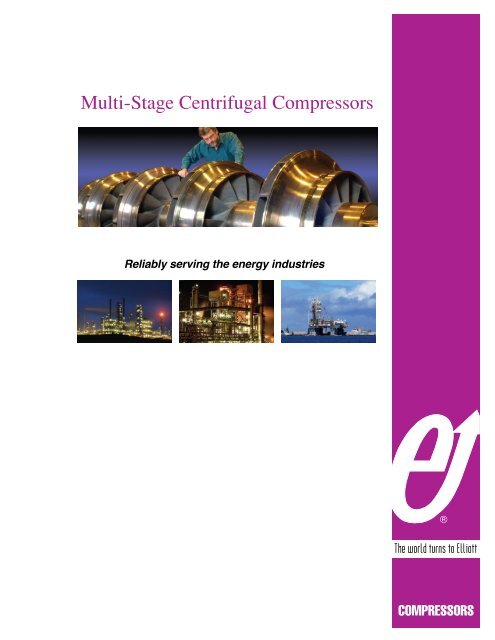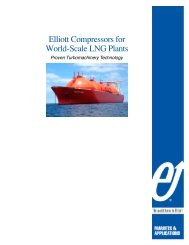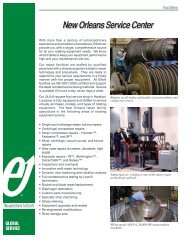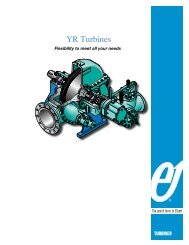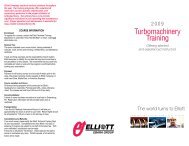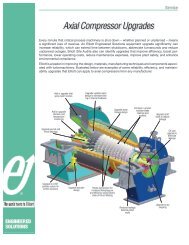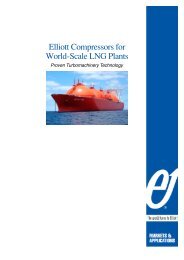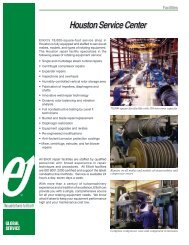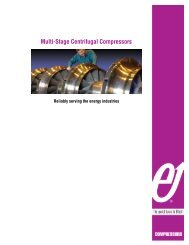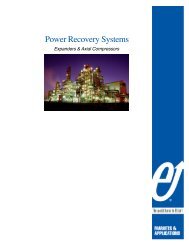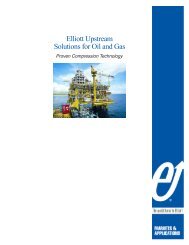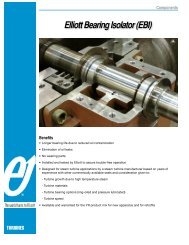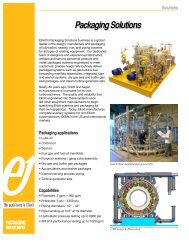Multi-Stage Centrifugal Compressors.pdf - Elliott Turbomachinery
Multi-Stage Centrifugal Compressors.pdf - Elliott Turbomachinery
Multi-Stage Centrifugal Compressors.pdf - Elliott Turbomachinery
Create successful ePaper yourself
Turn your PDF publications into a flip-book with our unique Google optimized e-Paper software.
<strong>Multi</strong>-<strong>Stage</strong> <strong>Centrifugal</strong> <strong>Compressors</strong><br />
Reliably serving the energy industries
2<br />
EvolutionaRy DEsigns<br />
REvolutionaRy REsults<br />
a History of innovation and success<br />
Since 1910, <strong>Elliott</strong> Company has earned a<br />
reputation for providing innovative solutions,<br />
unmatched expertise, and first-class service to<br />
the global turbomachinery marketplace. <strong>Elliott</strong><br />
has designed, tested, and installed some of the<br />
industry’s most rugged and dependable equipment.<br />
In fact, some <strong>Elliott</strong> compressors and turbines<br />
installed in the 1940s and 1950s are still in<br />
operation today, either as originally supplied or<br />
upgraded to handle new process conditions or<br />
more stringent environmental standards.<br />
We have been on the cutting edge of technological<br />
advancement throughout our history, consistently<br />
providing advanced technology in aerodynamics,<br />
rotor dynamics, process simulation, and<br />
Product lines<br />
• Single/<strong>Multi</strong>-<strong>Stage</strong> <strong>Centrifugal</strong><br />
<strong>Compressors</strong> (API 617)<br />
• Axial Air <strong>Compressors</strong> (API 617)<br />
• Single/<strong>Multi</strong>-<strong>Stage</strong><br />
Steam Turbines (API 611)<br />
• <strong>Multi</strong>-<strong>Stage</strong> Steam<br />
Turbines (API 612)<br />
metallurgy. Our customers have benefited from our<br />
state-of-the-art production innovations, including<br />
fabricated casing technology, high-pressure casing<br />
technology, and impeller welding techniques. The <strong>Elliott</strong><br />
EDGETM development program evolved from our<br />
commitment to providing new approaches, processes,<br />
and technology while maintaining the quality and reliability<br />
that our customers have come to expect.<br />
We understand that change is essential in achieving<br />
and maintaining a competitive edge in today’s business<br />
environment. Together with our customers and<br />
suppliers, we continue to innovate, improve, and expand<br />
our extensive portfolio of products and services<br />
that serve the energy industries.<br />
Product lines<br />
• Turbine Generators<br />
• FCC Power Recovery<br />
Expanders<br />
• Lubrication Oil Consoles<br />
(API 614)<br />
• Sealing Oil Consoles (API 614)<br />
• Buffer Gas Panels (API 614)<br />
• PLC-Based Control Systems<br />
applications<br />
• Oil Refineries<br />
• FCC Applications<br />
• Chemical/Petrochemical Plants<br />
• Ethylene Plants<br />
• Gas Lift/Gas Gathering<br />
• Gas Injection/Transport<br />
• LNG Facilities<br />
• Gas to Liquids<br />
• Ammonia Plants<br />
• Power Generation
superior Performance through<br />
advanced technology<br />
Through our EDGE development program, we<br />
combine our comprehensive knowledge of turbomachinery<br />
with the latest design software, manufacturing<br />
processes, and machine tools. As a result, <strong>Elliott</strong>’s<br />
multi-stage centrifugal compressors lead the industry<br />
in both performance and reliability.<br />
Increased Aerodynamic Efficiency<br />
<strong>Elliott</strong> uses state-of-the-art interactive design<br />
and prediction tools to optimize aerodynamic<br />
performance and increase flange-to-flange<br />
efficiencies. Compressor impeller and matched<br />
stationary flowpath components are developed using<br />
Computational Fluid Dynamics (CFD) analyses<br />
and other current design tools. Three-dimensional<br />
blade profiles, diffuser flow angles, crossover bend<br />
curvature, area ratio, and return channel vane<br />
shapes are optimized for each impeller<br />
stage to provide the best possible<br />
efficiency. Additional performance<br />
enhancements are achieved by improving<br />
the flow distribution channels<br />
at the inlet and discharge<br />
volutes and sidestream<br />
mixing areas. These enhancements<br />
allow us to provide<br />
some of the industry’s highest<br />
operational efficiencies.<br />
improved Rotor stability<br />
Characteristics<br />
Through extensive research in the fields of rotor-dynamic<br />
stability, aerodynamic cross-coupling stiffness,<br />
and rotor-bearing systems, we have developed<br />
proprietary analytical tools. Incorporating these<br />
developments into <strong>Elliott</strong> compressor designs has<br />
produced a number of product enhancements. For<br />
example, we’ve increased rotor stiffness by increasing<br />
shaft diameter, reducing impeller weight, and increasing<br />
journal bearing sizes. This allows higher torque<br />
transmission capabilities and higher-speed operation,<br />
with improved rotor stability characteristics, which are<br />
essential as gas densities and operating pressures<br />
increase.<br />
aDvanCED<br />
tECHnology<br />
3
Casing<br />
FEatuREs<br />
4<br />
We Perform under Pressure and Make Field assembly Easier<br />
<strong>Elliott</strong> designed our EDGE compressor casings to re- Vertically split MB-line compressors feature a comduce<br />
the required manufacturing steps and simplify plete inner casing assembly. This includes a horizon-<br />
field assembly. To achieve higher operating pressures, tally split inner casing with diaphragms, stationary<br />
we applied state-of-the-art solids modeling and finite seals, rotating elements, bolted-on endwalls, and<br />
element analysis techniques.<br />
shaft end seals. This module can be inserted or<br />
removed from the outer casing as a single piece,<br />
Small and mid-sized horizontally split casing sections<br />
are made from a single piece of rolled steel<br />
plate with horizontal flanges that are machined—not<br />
which simplifies compressor assembly and reduces<br />
turn-around times.<br />
welded—into the side. Cast steel casings are used We typically use milled flats for SAE flanged<br />
for some applications. High-strength casing through- connections, including endwall, spray nozzle, casbolts<br />
provide superior clamping forces. Endwalls are ing drain, bearing retainer, and equalizing line con-<br />
made from a single solid plate. The resulting casing nections. On smaller casings where space is limited,<br />
has fewer sealing surfaces, is easier to manufac- SAE flanges provide higher ratings and more compact<br />
ture and assemble, and has increased pressure<br />
capabilities compared to conventional designs.<br />
Larger horizontally split casings have rolled barrel<br />
sections with welded-on endplates and welded-on<br />
horizontal flanges.<br />
designs than ANSI flanges.<br />
EDgE Casing advantages<br />
• Integral horizontal flanges<br />
on small and medium frames<br />
• Solid endwalls with machined<br />
flats for bearing<br />
and seal connections<br />
• Machined flats with SAE<br />
flanges for most drain or injection<br />
connections<br />
• Through-bolts for casing horizontal<br />
flanges<br />
• Allowable forces and moments<br />
per API 617<br />
• Three-dimensional solid<br />
modeling for improved design<br />
and engineering review<br />
capability<br />
• Pro/ENGINEER solid<br />
modeling files to enhance<br />
precision during component<br />
manufacture
advanced aerodynamics and Enhanced Performance<br />
give our Customers the EDgE<br />
A key achievement of the EDGE develop-<br />
ment program is our ability to offer superior,<br />
three-dimensional impeller designs and stationary<br />
diaphragms. We do this by maximizing performance<br />
over a broad range of pressure and flow applications<br />
using the latest aerodynamic design and analysis<br />
technologies. To verify predicted performance, singlestage<br />
testing is performed in various configurations,<br />
such as with vaneless or vaned diffusers, or using<br />
high or low tip Mach numbers. Higher and lower flow<br />
stage ratings are derived from the prototype test data<br />
to form a “family” of stages. Within each stage family,<br />
impeller geometry is fixed; blade heights are varied for<br />
higher or lower flows. Using this methodology, several<br />
stage families are used to span the desired flow coefficient<br />
range. Impellers and stationary components<br />
are then scaled up or down for different frame sizes.<br />
For maximum flexibility, EDGE aerodynamic<br />
components are also scalable from<br />
90 percent to 100 percent size<br />
within each compressor<br />
frame size.<br />
Impeller manufacturing applies five-axis milling to<br />
ensure the quality of the advanced impeller designs.<br />
Impellers are stress relieved, machine finished, balanced<br />
statically and dynamically, spin tested, and then<br />
mounted with an interference-fit onto the shaft. Shaftto-impeller<br />
keys are used for extra stability in high<br />
pressure or high power applications.<br />
EDGE compressors use either fabricated steel<br />
diaphragms or a combination cast-and-fabricated<br />
steel design where thickness precludes using steel<br />
plate alone. Precision machining ensures dimensional<br />
accuracy and significantly improves the diaphragm<br />
surface finish. Diaphragms are horizontally split and<br />
finished at all horizontal and peripheral joints and on<br />
gas path surfaces.<br />
aERoDynaMiC<br />
CoMPonEnts<br />
5
Cast nozzles reduce manufacture<br />
time and allow higher ratings<br />
Elimination of dished heads<br />
increases pressure ratings<br />
Increased journal bearing<br />
and shaft seal sizes<br />
Non-radial inlet guide vanes<br />
improve flow distribution<br />
6<br />
PRovEn tuRboMaCH
inERy tECHnology<br />
Increased shaft diameter<br />
enhances rotor dynamics<br />
Precisely designed and<br />
machined diaphragms<br />
CFD ensures proper side-<br />
stream mixing<br />
High-efficiency impellers<br />
scale frame-to-frame<br />
7
otHER<br />
FEatuREs<br />
8<br />
We’ve Paid Careful attention to Every Detail<br />
As part of our comprehensive EDGE develop-<br />
ment program, <strong>Elliott</strong>’s engineers examined each<br />
compressor component to find ways to support<br />
our goals of higher efficiency, lower cost, simpler<br />
maintenance, and reduced cycle time. Our designs<br />
reflect our commitment to making our products the<br />
best in the industry, down to the last detail.<br />
Interstage and balance piston sealing is<br />
accomplished through two component features.<br />
First, we use abradable or deflection-tolerant<br />
materials such as fluorosint or nickel-graphite on<br />
stationary sealing surfaces. Second, we machine<br />
teeth onto the rotating surfaces. These features<br />
increase efficiency by reducing gas recirculation<br />
and minimizing the potential for shut-downs<br />
resulting from damaged seals.<br />
<strong>Elliott</strong> offers shaft seals to meet our customers’<br />
needs in all applications. Dry gas seals are standard<br />
and are available as single, tandem, double, or<br />
triple designs. The tandem or triple gas seal designs<br />
include an intermediate labyrinth, which can be buffered<br />
for additional emissions protection. Our customers<br />
realize cost savings by eliminating expensive seal<br />
oil systems and the need to dispose of contaminated<br />
oil. Gas seal buffer system engineering and manufacturing<br />
are available at <strong>Elliott</strong>’s Donora, Pennsylvania,<br />
plant.<br />
Alternative seal designs include labyrinth or<br />
dry carbon ring seals for low pressure services,<br />
mechanical contact seals (<strong>Elliott</strong>’s patented<br />
Iso-carbonTM design), and bushing seals (<strong>Elliott</strong>’s<br />
Iso-sleeveTM design). For mechanical contact and<br />
bushing seals, a cartridge design is also available.<br />
This enables easier installation and removal of the<br />
complete seal assembly. Buffer connections are standard<br />
for all seal designs.<br />
Reliability, quality, and safety are hallmarks of all<br />
<strong>Elliott</strong>-designed components. For example, as a design<br />
standard, replaceable journal bearings are steelbacked<br />
and babbitt-lined with a five-shoe tilting pad.<br />
Thrust bearings are double-acting and self-equalizing.<br />
Center pivots typically are used to make assembly<br />
easier and to provide maximum protection if reverse<br />
rotation occurs. Chrome-copper pads are applied for<br />
both journal and thrust bearings for high oil temperature<br />
applications.
a Commitment to World‑Class Manufacturing<br />
<strong>Elliott</strong> employs high-quality produc-<br />
tion techniques that minimize cycle<br />
time and costs while providing our<br />
customers with the most competitive<br />
and reliable products. Our<br />
engineering and manufacturing<br />
facilities in Jeannette, Pennsylvania,<br />
and Sodegaura, Japan, rank<br />
among the world’s most advanced<br />
for turbomachinery design,<br />
production, and testing.<br />
Our combined manufacturing<br />
capabilities include Masterhead<br />
machining centers for casing machining,<br />
rotor machining centers,<br />
and diaphragm machining centers.<br />
Our rotor balancing facilities<br />
include a state-of-the-art Schenck<br />
Trebel-designed balancing<br />
machine housed in a bunker-style<br />
vacuum chamber. The top of this<br />
reinforced concrete facility slides<br />
away via hydraulic motors, permitting<br />
rotors to be lowered onto the<br />
balancing equipment.<br />
Our recently modernized and<br />
expanded test facilities enable<br />
us to validate the mechanical<br />
integrity and performance<br />
of our components and overall<br />
systems. Our new main test<br />
facility, which increased our<br />
capacity by 50 percent, contains<br />
a high-volume, closed loop,<br />
specially designed cooling system<br />
with the capacity for testing gas<br />
turbine-driven compressor trains<br />
at full loads up to 100,000 HP.<br />
Masterhead casing center Diaphragm machining cell High-speed balance facility<br />
ManuFaCtuRing<br />
anD<br />
tEsting<br />
CaPabilitiEs<br />
9
CoMPREssoR<br />
FRaME<br />
suMMaRiEs<br />
10<br />
standardization of Components<br />
In developing the EDGE compressor product line,<br />
we focused on standardizing components and hardware<br />
to reduce costs and improve reliability across<br />
a wide array of applications. The EDGE product line<br />
consists of 15 standard frame sizes, which are scaled<br />
from the 38M median frame size. Casing bores and<br />
internal aerodynamic hardware, such as impellers,<br />
2,000<br />
137.90<br />
2,000<br />
137.90<br />
1,500<br />
103.42<br />
2,000<br />
103.42<br />
diaphragms, and shafts, are scaled. Scaling aerody-<br />
namic components improves performance predictabil-<br />
ity and increases reliability by preserving geometric<br />
similarity across frame sizes. Bearings and seals are<br />
selected from vendor standard sizes for each application.
WEigHts<br />
anD<br />
DiMEnsions<br />
ConFiguRations<br />
11<br />
In-Line<br />
In-Line<br />
with Side-Streams<br />
In-Line<br />
with Iso-Cooling<br />
Double-Flow<br />
Back-to-Back<br />
Iso-Cooler Optional
901 North Fourth Street<br />
Jeannette, PA 15644-1473, USA<br />
(PH) 724-527-2811 (FAX) 724-600-8442<br />
For a complete contact listing of our global sales and service network,<br />
please visit us at www.elliott-turbo.com<br />
EDGE1 508


